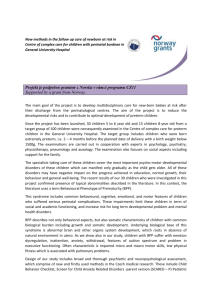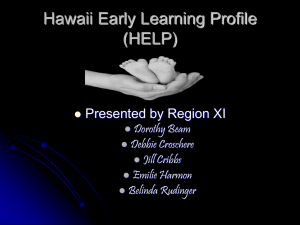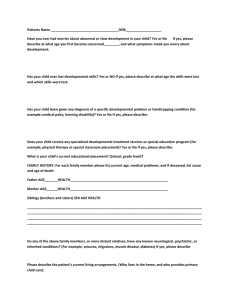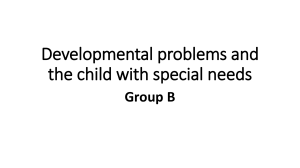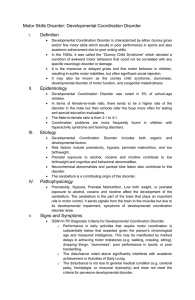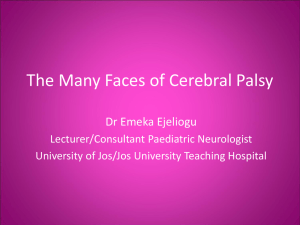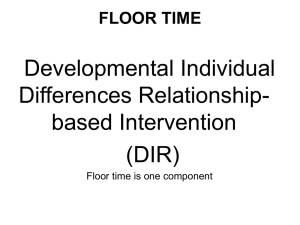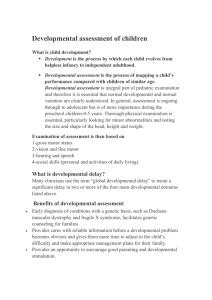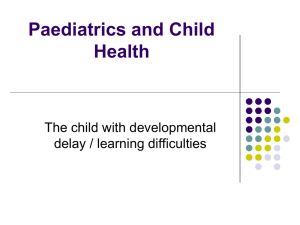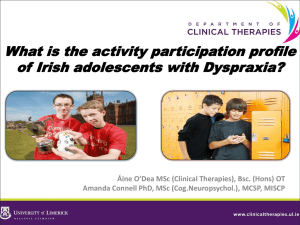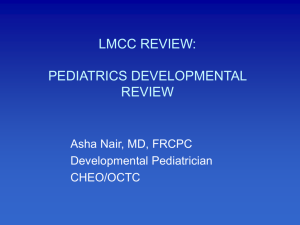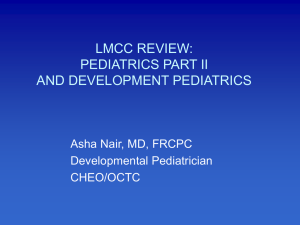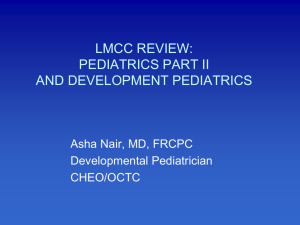Delayed Developmental Milestones – Dr. Khalid
advertisement
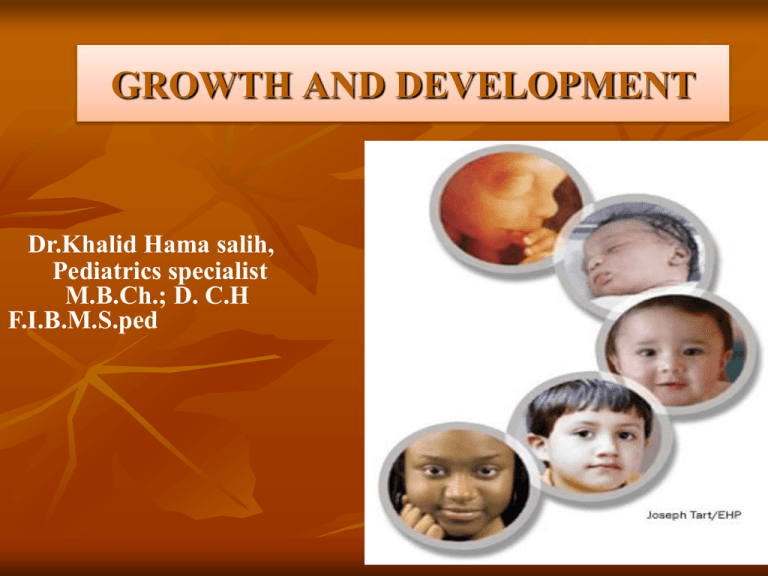
GROWTH AND DEVELOPMENT Dr.Khalid Hama salih, Pediatrics specialist M.B.Ch.; D. C.H F.I.B.M.S.ped 3 Introduction: An estimated 12-16% of children have a developmental and/or behavior disorder Only 30% are identified before school entrance Those detected after school entrance miss out on early intervention services proven to have long term health benefits Delay - implies slow acquisition of all skills (global delay) or of one particular field or area of skill (specific delay), particularly in relation to developmental problems in the 0-5 years age group. Development delay the condition where a child does not reach one of the stages of development at the expected For example, if the normal range for learning to walk is between 9 and 15 months, and a 20month-old child has still not begun walking, this would be considered a developmental delay. prenatal genetic Chromosome/DNA disorders, e.g. Down's syndrome, fragile X syndrome Cerebral dysgenesis, e.g. microcephaly, absent corpus callosum, hydrocephalus, neuronal migration disorder, vascular occlusion metabolic Hypothyroidism, phenylketonuria teratopgenic Alcohol and drug abuse Congenital infection Rubella, cytomegalovirus, toxoplasmosis ncs Tuberous sclerosis, neurofibromatosis Perinatal Extreme prematurity Intraventricular haemorrhage/periventricular leucomalacia Birth asphyxia Hypoxic-ischaemic encephalopathy metabolic Symptomatic hypoglycaemia, hyperbilirubinaemia Postnatal l infection Meningitis, encephalitis anoxia Suffocation, near drowning, seizures trauma Head injury - accidental or non-accidental The severity can be categorised as: mild moderate severe profound Types of delay 1.Global developmental delay implies delay in acquisition of all skill fields (gross motor, vision and fine motor, hearing and speech/language, social/emotional and behaviour). It usually becomes apparent in thefirst 2 years of life. . However, some children present later with, for instance, delay in speech and language but review of their developmental history may reveal delayed gross and fine motor Global developmental delay is likely to be associated with cognitive difficulties although these may only become apparent several years later. 2.Specific developmental delay is when one field of development or skill area is more delayed than others or is developing in a disordered way Abnormal motor development This may present as delay in acquisition of motor milestones, e.g. head control, rolling, sitting, standing, walking or as problems with balance, an abnormal gait, asymmetry of hand use, involuntary movements or rarely loss of motor skills. Concern about motor development usually presents between 6 months and 2 years of age when acquisition of motor skills is occurring most rapidly Causes of abnormal motor development include: cerebral palsy congenital myopathy/primary muscle disease spinal cord lesions, e.g. spina bifida global developmental delay as in many syndromes or of unidentified cause Fine motore &vision: Visual impairment may present in infancy with: loss of red reflex from a cataract a white reflex in the pupil, which may be due to retinoblastoma, cataract or retinopathy of prematurity (ROP). not smiling responsively by 6 weeks post-term lack of eye contact with parents visual inattention, random eye movements nystagmus ,squint photophobia Hearing speech and language Abnormal speech and language development A child may have a deficit in either receptive or expressive speech and language, or both. The deficit may be a delay or a disorder. Speech and language delay may be due: global developmental delay to hearing loss difficulty in speech production from an anatomical deficit, e.g. cleft palate, or oromotor incoordination, e.g. cerebral palsy environmental deprivation/lack of opportunity for social interaction normal variant/familial patter Abnormal development of social/communication skills Children who fail to acquire normal social and communication skills may have an autistic spectrum disorder. The prevalence of autistic spectrum disorder is 3-6/1000 live births. It is more common in boys. Presentation is usually between 2 and 4 years of age when language and social skills normally rapidly expand. The children present with a triad of difficulties and associated co-morbidities Developmental Quotient (DQ) Divide child’s developmental or best milestone age (DA) by child’s chronological age (CA) DQ = DA/CA x 100 DQ of 100 = mean or average rate DQ < 70 is approx. 2 standard deviations below the mean Developmental Quotient DQ > 80 may be considered normal DQ 70-80 borderline DQ < 70 is abnormal Investigations or assessment to karyotypeCytogenetic 4-2. abnormal developmTable *Fragile X analysis DNA FISH analysis, e.g. for chromosome 7, 15 consider for ent Chromosome* Metabolico Thyroid function tests, liver function tests, bon chemistry, urea and electrolytes, plasma a Creatine kinase, blood lactate, VLCFA (very lo chain fatty acids), ammonia, blood gases, white (lysosomal) enzymes, urine amino and organic acids, urine mucopolysaccharides (GAG) reduc substanc Maternal amino acids for raised phenylala Infection Congenital infection screen Imaging CT and MRI brain scans Skeletal survey Cranial ultrasound in newborn Neurophysiology EEG (may be specific for seizures, some progressive neurological disorders) Nerve conduction studies, EMG, VEP (visual management Assistive technology (devices a child might need) Audiology or hearing services Counseling and training for a family Educational programs Medical services Nursing services Nutrition services Occupational therapy Physical therapy Psychological services Respite services Speech/Language

